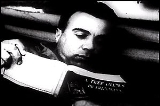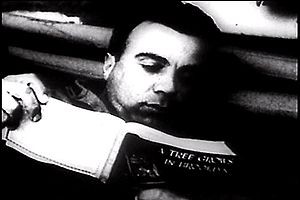
Armed Services Editions
Encyclopedia
Armed Services Editions were small, compact, paperback books printed by the Council on Books in Wartime
for distribution within the American military during World War II
. This program was in effect from 1943 to 1946. The ASEs were designed to provide entertainment to soldiers serving overseas, while also educating them about political, historical, and military issues. The slogan of the Council on Books in Wartime was, "Books are weapons in the war of ideas
."

For a list of titles in the series, and to see how the books were numbered, see http://www.armedserviceseditions.com/ASE%20Listing%20by%20Title.htm
Armed Services Editions were printed on digest and pulp magazine presses, usually in two columns per page for easier reading. Some ASEs were stapled along the binding, in addition to being glued, to make them sturdier. Because the Council on Books in Wartime made use of magazine presses to print ASEs when the presses were not in use, printing costs were low. The cost for printing was around 6 cents per copy, and royalties of one cent per copy were split between authors and publishers. This early experiment with mass paperback printing helped to prove the viability of paperback publishing in the United States.
A complete set of ASEs is owned by the Library of Congress
. Near-complete sets are in the libraries of the University of Alabama
, the University of South Carolina
and the University of Virginia
. University of Notre Dame
boasts 1064 titles, and the University of Texas, the University of Rochester
, Princeton University
, Dartmouth College
and the University of Wisconsin–Madison
have special Armed Services Edition collections, as do many other libraries.
In addition to the sets belonging to institutions, as listed above, there is one known complete set and another near-complete set (missing 2 books) which are held by private collectors.
Council on Books in Wartime
The Council on Books in Wartime was an American non-profit organization founded by booksellers, publishers, librarians, authors, and others, in the spring of 1942 to channel the use of books as "weapons in the war of ideas"...
for distribution within the American military during World War II
World War II
World War II, or the Second World War , was a global conflict lasting from 1939 to 1945, involving most of the world's nations—including all of the great powers—eventually forming two opposing military alliances: the Allies and the Axis...
. This program was in effect from 1943 to 1946. The ASEs were designed to provide entertainment to soldiers serving overseas, while also educating them about political, historical, and military issues. The slogan of the Council on Books in Wartime was, "Books are weapons in the war of ideas
War of ideas
The War of Ideas is a clash of opposing ideals, ideologies, or concepts through which nations or groups use strategic influence to promote their interests abroad...
."

ASE Titles
The ASE program featured an array of fiction and non-fiction titles, including classics, contemporary bestsellers, biographies, drama, poetry, and genre fiction (mysteries, sports, fantasy, action/adventure, westerns). Non-fiction books included biographies, religious/self-help titles, and science titles. Most of these books were printed in unabridged versions. The distinctive covers bore the description, "Armed Services Edition: This is the Complete Book-- Not a Digest." 91 of the titles printed were abridged, usually for length rather than content. These bore the slogan, "Condensed for wartime reading," or slight variations such as "Slightly condensed for rapid reading." Over the life of the program, over 123 million copies of 1,322 titles were printed. This makes the ASE program one of the largest wide-scale distributions of free books in history.For a list of titles in the series, and to see how the books were numbered, see http://www.armedserviceseditions.com/ASE%20Listing%20by%20Title.htm
Publishing
The small books were convenient for soldiers because they fit easily into a cargo pocket. Finished size varied slightly, from 5½" to 6½" long and from 3⅞" to 4½" high. (Unlike traditional paperbacks, ASEs were bound on the short side of the text block rather than the long side, due to the printing presses used.)Armed Services Editions were printed on digest and pulp magazine presses, usually in two columns per page for easier reading. Some ASEs were stapled along the binding, in addition to being glued, to make them sturdier. Because the Council on Books in Wartime made use of magazine presses to print ASEs when the presses were not in use, printing costs were low. The cost for printing was around 6 cents per copy, and royalties of one cent per copy were split between authors and publishers. This early experiment with mass paperback printing helped to prove the viability of paperback publishing in the United States.
Popularity
ASEs were apparently very popular among the armed forces. Copies were shared, re-read, and ripped in half so they could accommodate two readers at once. A contemporary newspaper article recounted, "The hunger for these books, evidenced by the way they are read to tatters, is astounding even to the Army and Navy officers and the book-trade officials who conceived Editions for the Armed Services" (Wittels, 11). For some readers, the ASEs were the first books they had picked up since high school.Armed Services Editions Today
Today, many Armed Services Editions are still readily available from used booksellers. However, the rarer titles from the series are difficult to find and very valuable. The scarcest tend to be the titles produced at the beginning and the ending of the series. Other titles, such as Superman and A Rose for Emily, are more common but valuable because they appeal to a wider array of collectors.A complete set of ASEs is owned by the Library of Congress
Library of Congress
The Library of Congress is the research library of the United States Congress, de facto national library of the United States, and the oldest federal cultural institution in the United States. Located in three buildings in Washington, D.C., it is the largest library in the world by shelf space and...
. Near-complete sets are in the libraries of the University of Alabama
University of Alabama
The University of Alabama is a public coeducational university located in Tuscaloosa, Alabama, United States....
, the University of South Carolina
University of South Carolina
The University of South Carolina is a public, co-educational research university located in Columbia, South Carolina, United States, with 7 surrounding satellite campuses. Its historic campus covers over in downtown Columbia not far from the South Carolina State House...
and the University of Virginia
University of Virginia
The University of Virginia is a public research university located in Charlottesville, Virginia, United States, founded by Thomas Jefferson...
. University of Notre Dame
University of Notre Dame
The University of Notre Dame du Lac is a Catholic research university located in Notre Dame, an unincorporated community north of the city of South Bend, in St. Joseph County, Indiana, United States...
boasts 1064 titles, and the University of Texas, the University of Rochester
University of Rochester
The University of Rochester is a private, nonsectarian, research university in Rochester, New York, United States. The university grants undergraduate and graduate degrees, including doctoral and professional degrees. The university has six schools and various interdisciplinary programs.The...
, Princeton University
Princeton University
Princeton University is a private research university located in Princeton, New Jersey, United States. The school is one of the eight universities of the Ivy League, and is one of the nine Colonial Colleges founded before the American Revolution....
, Dartmouth College
Dartmouth College
Dartmouth College is a private, Ivy League university in Hanover, New Hampshire, United States. The institution comprises a liberal arts college, Dartmouth Medical School, Thayer School of Engineering, and the Tuck School of Business, as well as 19 graduate programs in the arts and sciences...
and the University of Wisconsin–Madison
University of Wisconsin–Madison
The University of Wisconsin–Madison is a public research university located in Madison, Wisconsin, United States. Founded in 1848, UW–Madison is the flagship campus of the University of Wisconsin System. It became a land-grant institution in 1866...
have special Armed Services Edition collections, as do many other libraries.
In addition to the sets belonging to institutions, as listed above, there is one known complete set and another near-complete set (missing 2 books) which are held by private collectors.
Further reading
- Cole, John Young [Editor]. Books In Action: The Armed Services Editions. Available online through Library of CongressLibrary of CongressThe Library of Congress is the research library of the United States Congress, de facto national library of the United States, and the oldest federal cultural institution in the United States. Located in three buildings in Washington, D.C., it is the largest library in the world by shelf space and...
Center for the BookCenter for the BookThe Center for the Book was founded in 1977 by Daniel J. Boorstin, the Librarian of Congress, in order to use the Library of Congress to promote literacy, libraries, and reading in general, as well as an understanding of the history and heritage of American literature...
http://www.loc.gov/catdir/toc/becites/cfb/84600198.html - Jamieson, John. Books for the Army. New York: Columbia University Press, 1950.
- Miller, Daniel [Curator]. Books Go To War. Online exhibition at the University of Virginia Library. http://www.lib.virginia.edu/small/exhibits/ase/
- Wittels, David. "What the G. I. Reads." Saturday Evening Post, June 23, 1945. P. 11, 91-92.

